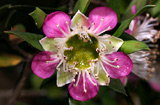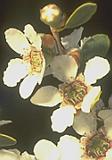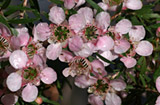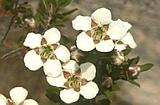|
[Front Page] [Features] [Departments] [SGAP Home Page] [Subscribe]

Leptospermum
Colin Cornford
Leptospermum seems to be a somewhat forgotten genus which is worthy of more attention.
Johann Reinhold Forster (1729-98) and his son Johann George Adam Forster (1754-94) described "Leptospermum" in 1776, but separation of the species remained difficult. Bentham named several species in 1867. Briggs and Johnson produced an acceptable generic classification for Myrtaceae, based on inflorescence structure, in 1979. In 1989 a revision of Leptospermum by Thompson was published. Bean conducted further revision in 1992.
The name Leptospermum originates from the Greek "leptos" - fine or slender; and "sperma" - a seed. Most people are aware of the various cultivars of the New Zealand form of Leptospermum scorparium, which have been available in nurseries for many years. My experience with these has been that they require a cool climate with well drained soil conditions for optimum growth. Leptospermum scorparium also occurs in Tasmania.
 |
Leptospermum macrocarpum shows the typical shape of the flowers. This species has the largest flowers in the genus.
Select the thumbnail image or plant name for a higher resolution image.
|
In the 1988 edition of "Rare or Threatened Australian Plants" by Briggs and Leigh, twenty-one Leptospermum species are listed. These include Leptospermum epacridoideum, L.glabrescens, L.luehmannii, L.maxwellii, L.sericeum, L.wooroonooran and some listed as "species 1 to species 16". No doubt, some of these species are now named or have been classified as identical to some previously named species.
In all cases, with the exception of 6 species, the species listed are protected in reserves. Details of these six are:
- Leptospermum glabrescens - poorly known (Vic)
- Leptospermum sp.4(sp.'y' Clyde Mt.) - vulnerable (NSW)
- Leptospermum sp.8 (sp.'b' of Die Hardy Range) - poorly known (WA)
- Leptospermum sp.13 (sp.'f', Londry - Daniell - Esp) poorly known (WA)
- Leptospermum sp.14 (sp.'N' Nowra area) - poorly known (NSW)
- Leptospermum sp.15(sp.'H' Pennant Hills) - vulnerable (NSW)
Leptospermum species are commonly called "tea - tree". This name arose from the practice of early settlers using an infusion of leaves of aromatic species in hot water to make a tea substitute.
The general description of the genus states:
"Shrubs or small trees. Leaves alternate, entire. Flowers solitary or 2 or more together at ends of short branches or in leaf axils, bracts scarios, usually early deciduous, bracteoles close under hypanthium; hypanthium adnate to ovary at base;sepals 5; petals 5, spreading; stamens numerous, free, not or scarcely longer than petals, anthers versatile, connective with globular gland; ovary usually 3-5 locular, occasionally 6-12 locular. Fruits capsules, valves usually protruding from persistent hypanthium."
 |
Leptospermum lanigerum is a common large shrub in coastal districts of eastern Australia. It sometimes reaches tree size.
Select the thumbnail image or plant name for a higher resolution image (23k).
|
The range of Leptospermum species covers S.E. Asia, New Guinea, New Zealand and Australia. About 80 species are endemic to Australia.
Flower Colours
White is the predominant flower colour, but there are a few species which produce pink or red flowers:
- Leptospermum epacridoideum - mostly white, but pink forms occur.
- Leptospermum erubescens - white or pink.
- Leptospermum incanum - white or pink - white or pink
- Leptospermum liversidgei - white , but pink forms occur.
- Leptospermum macrocarpum - pink to red, can also be greenish - white
- Leptospermum nitens - white or pink.
- Leptospermum "Pink Cascade" - pink (said to be hybrid of L."Pacific Beauty" and L.continentale). The plants in our garden flower heavily in spring, but usually have some flowers all year round.
- Leptospermum rotundifolium - pink.
- Leptospermum scoparium - white with pink and red forms occurring.
- Leptospermum sericeum - pink.
- Leptospermum spectabile - red
- Leptospermum shaerocarpum - greenish-white or pink.
- Leptospermum spinescens - greenish-cream.
- Leptospermum squarrosum - pink.
- Leptospermum venustum - pink.
- Leptospermum lanigerum - can form dense thickets in Tasmania. Plants of this species on Sarah Island in Macquarie Harbour are 8-10 metres tall with trunk diameters up to 200mm.
 |
A recently named species is Leptospermum spectabile which is found on the Colo River near Sydney.
Select the thumbnail image or plant name for a higher resolution image (28k).
|
 |
Leptospermum "Pink Cascade" is a cultivar which has become very popular in recent years. It forms a small, weeping shrub.
Select the thumbnail image or plant name for a higher resolution image (43k).
|
Other Features
Some Leptospermum species and cultivars are worth growing for the colour of trunk or foliage. A few examples are:
Leptospermum luehamanii - this plant has spectacular light brown bark which contrasts well with the bright, glossy foliage. It sheds its bark each year to display new bark in varying shades of green, which gradually revert to brown.
Leptospermum brachyandrum - the bark of this plant is basically pale-coloured, but is shed in strips to reveal glossy areas of pinks, greys and browns. the fine, deeply weeping foliage is also an attractive feature.
Leptospermum "Copper Glow" - a form of L.polygalifolium, but with more dense, deep green foliage. New growth is a copper-bronze colour, which contrasts well with the deep green foliage and helps to show off the fairly abundant white flowers.
Leptospermum "Copper Sheen" - the origin of and its parentage is uncertain. It was marked as a form of L.nitidum, but the mainland form of L.nitidum has been re-named L.turbinatum; so I will leave it at that. It is a low shrub with copper coloured foliage, which provides good contrast to foliage of other plants and shows off its creamish-green flowers to advantage.
Cultivated Species and Forms
In the Brisbane area Leptospermum species are not widely used in garden or park planting. Species most commonly used are:
Leptospermum petersonii - the lemon-scented Tea-tree, which maybe used as a specimen plant, in group plantings, or occasionally for hedge plantings. Leaves can be used to give lemon-flavour to tea.
Leptospermum "Pacific Beauty' - used as a garden plant and as a landscape plant. It is spectacular when in flower in early spring. It is available in prostrate or semi-prostrate forms. Can grow to about 1.2m high by up to 2.5m wide and generally maintains good shape and density of foliage.
Leptospermum brachyandrum - this is fairly widely grown for its attractive weeping habit and for its attractive bark. Flowers are white, generally small and not prominent.
Leptospermum laevigatum - used occasionally in landscape projects, but not widely used in gardens. Its greyish-green foliage, fairly abundant white flowers and generally rounded shape make it an attractive shrub. Although its natural habitat is coastal heathland, it appears to adapt readily to a wide range of soil and climatic conditions. There is some evidence that L.laevigatum can present problems in coastal heathland where it tends to regenerate rapidly following fire or clearing, and can suppress or prevent development of smaller growing coastal and heathland plants. It has become quite dense in some areas of the far north coast of NSW, where it was planted in previously sand-mined areas.
Leptospermum "Copper-Glow" - this was readily available in local nurseries a few years ago , but doesn't appear to have retained its popularity. It is hardy in most conditions and its bronze-coloured new growth provides good foliage contrast. It grows to about 2.5m by 2.5m.
Leptospermum "Cardwell" - this is thought to be a form of L.polygalifoilum ssp.tropicum and is a very floriferous plant. It grows to about 2m by 2m, but the lower branches tend to become straggly with age. It is still readily available in local nurseries.
Leptospermum polygalifolium - this is grown fairly widely in garden situations in company with other plants. Because it can become open and a bit straggly with age, it is not suitable for specimen planting. It can be relied on to provide a good display of flowers each spring.
Leptospermum madidum - (previously L.longifolium) this is not widely grown, but is attractive with its weeping foliage and peeling,
multicoloured bark. It flowers well, but the tiny white flowers are not prominent.
A recent appearance in local nurseries is Leptospermum "Scarlet Cascade", with a common description of "weeping dwarf red tea-tree". According to the label, it grows to about 0.5m with a spread of 1.0m or so. It is reputed to be a form of L.scoparium, but whether of the New Zealand to Tasmanian provenance is not known.
Pruning
My experience with pruning of Leptospermum species has indicated that they don't like heavy pruning and are not all too happy with only light pruning . It appears that , unlike many Australian plants, they don't produce many, if any, epicormic buds which produce regrowth following pruning or fire.
 |
Leptospermum turbinatum is restricted to small areas in Victoria and South Australia. L.nitidum from Tasmania is similar.
Select the thumbnail image or plant name for a higher resolution image (27k).
|
Pests and Diseases
The main problems I have experienced have been caused by a small white scale insect which appears in fairly large numbers and affects growth rates. The other problem experienced has been with leaf and twig webbers. They bind a mass of leaves and twigs together from where the caterpillars emerge by night to feed on adjacent leaves.
The scale insects can be fairly readily controlled with white oil/carbaryl spray in summer. The leaf and twig webbers can be controlled by carbaryl spray or hand removal of nests. Unless the leaf and twig webber infestation is very severe, the problem is usually one of unsightliness rather than one of major plant damage.
From the September 1996 issue of the "Bulletin", the newsletter of the Queensland Region of the Society for Growing Australian Plants.
Colin Cornford is the leader of the Society's Melaleuca and Allied Genera Study Group.

[Front Page] [Features] [Departments] [SGAP Home Page] [Subscribe]
Australian Plants online - September 1998
The Society for Growing Australian Plants
|